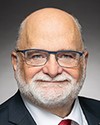Thank you.
My questions are for the people from the RCMP.
Thank you, by the way, Mr. Larkin, for having shown us the RCMP vault a few weeks ago in Ottawa. I think that it's a visit the members ought to have made well before the start of the study of the bill. It certainly opened our eyes on various matters.
My colleague Mr. Lloyd spoke earlier about airsoft-type weapons, and said that it would be rather unusual to try to use an airsoft component in a real weapon to make it functional. Some witnesses had told us that if the attempt were made, it would likely not work very well.
And yet, in the RCMP vault, we saw that this was becoming increasingly widespread, and that replica firearms and airsoft-type firearms looked so much like the real thing that it was easy to do.
I was wondering whether there might not be an easy way of forcing manufacturers to make sure that components used in airsoft guns did not match or fit in real firearms. People who do sport shooting can't be prevented from doing so, but it's clear that the practice is becoming more widespread.
I realize that that this is a long preamble, but according to you, Mr. Larkin, is this something you have seen and is it becoming more widespread? Do you have the resources required to deal with it?
Ms. Paquette could also answer the question.





